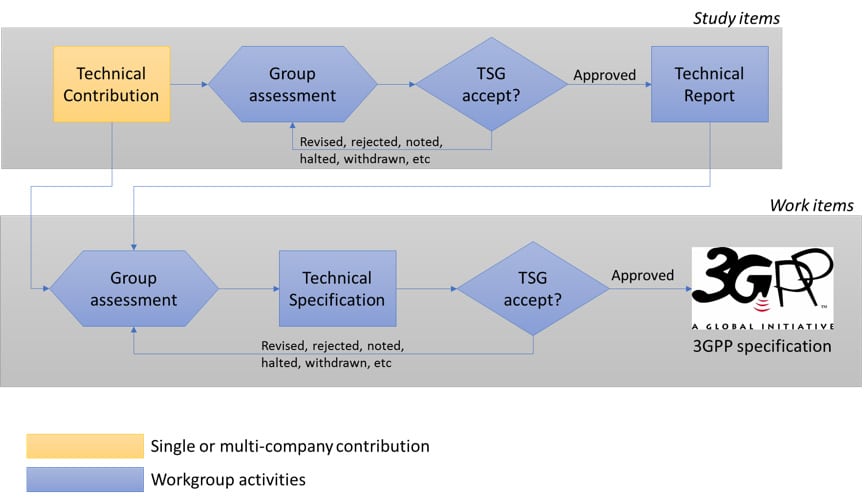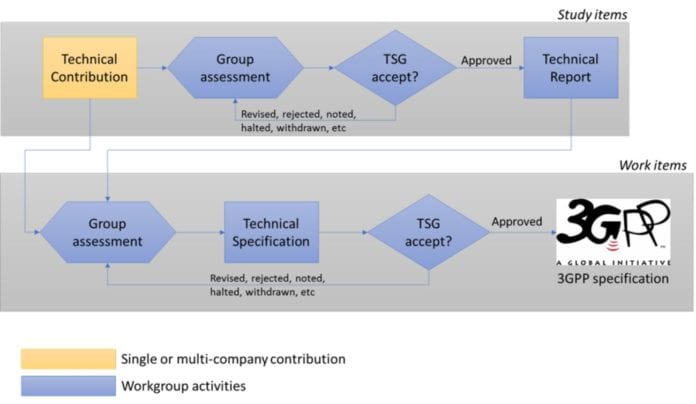The 3rd Generation Partnership Project (3GPP) met this week in San Diego, California, to finalize Release 15, which includes 5G New Radio (NR), and set the workplan for Release 16, which includes several enhancements to 5G, including the full specification of the Next Generation Core (NG Core) and Ultra Reliable and Low Latency Communications (URLLC). Contrary to popular belief, the 3GPP is not a standards organization, but a partnership project with Standard Setting Organizations (SSOs) agreeing to collaborate to produce global Technical Reports (TRs). These very same standards organizations are then responsible for issuing technical standards and enforcing Intellectual Property Rights (IPR) laws throughout the regions they govern. Because of its technical contributions, a 3GPP member company can seek IPR in the SSO regions. These SSO regions include: Japan (Association of Radio Industries and Business (ARIB) and Telecommunication Technology Committee (TTC)); the United States (Alliance for Telecommunications Industry Standards (ATIS)); China (China Communications Standards Association (CCSA)); Europe (European Telecommunication Standards Institute (ETSI)); India (Telecommunications Standards Development Society, India (TSDSI)); and Korea (Telecommunications Technology Association (TTA)). The 3GPP also includes several market representation partners, including the GSM Association (GSMA), Next Generation Mobile Networks (NGMN), Small Cell Forum, and many more, which aid the partnership project with market advice and consensus.
Essentially, the 3GPP is a collaboration effort, with stakeholders from around the world meeting to decide and distill years of research into commonly agreed upon technical specifications, which later become standards and, eventually, the hardware and software that powers the mobile telco market.
3GPP process for establishing a technical specification
A 3GPP Technical Specification (TS) is the formal output of the 3GPP, which is then used by the industry to create standard equipment and software that powers telco networks. The 3GPP consists of three main Technical Specification Groups (TSGs), each of which includes several workgroups. The TSGs are Radio Access Network (RAN), Service and System Aspects (SA), and Core Network and Terminals (CT). Each top-level specification is arguably a massive undertaking for any single group and is, thus, broken down into smaller work items that are handled by the workgroups within each TSG. For example, the physical layer (OSI Layer 1) is handled by the TSG RAN1 working group, which is responsible for addressing several RAN topics, including but not limited to operation of Long-Term Evolution (LTE) in unlicensed spectrum, 5G NR, Cellular Vehicle-to-Everything (C-V2X) enhancements, and 1024QAM for LTE. The first process for establishing a new feature is a study item, with the corresponding TSG accepting contributions and creating a TR, which is then translated to work items if the study item is deemed important enough for consideration.

It should be noted that Change Requests (CRs) submitted after the TS is published are excluded from Figure 1 above and take place after the processes depicted therein. These contributions may range from important (e.g., correcting an omission that is critical for the operation of the network) to trivial (e.g., spelling mistakes in the TS report). There are also several CRs that are important but do not necessarily contribute to the evolution of the technology itself. For example, in recent 3GPP meetings, there have been several CRs submitted by mobile service providers, which have requested more combinations of Carrier Aggregation in different bands and the application of C-V2X in several LTE bands. These are important enough for the deployment of 3GPP specifications in the real world but do not advance mobile network technology.
After establishing work items, the process to create a TS is as follows: a company submits a contribution that is discussed during workgroup meetings that usually take place once every 1 or 2 months. The rapporteur of the workgroup is responsible for drafting the contribution (if there is consensus that this is indeed a meaningful contribution) into a TR, which is then discussed on an offline basis between the workgroup members. As soon as the workgroup decides that the TR has reached 90% completion, the rapporteur then creates the draft TS, which is formalized during the next TSG meeting and enters the formal process for becoming a standard. After the TS is submitted, participants can submit CRs, which may range from significant changes to mere typographical errors. It should also be noted that a large number of CRs are not approved and, thus, bear near-zero effect on 3GPP outputs and the market itself.
Understanding the 3GPP leadership and IPR
The process to create a standard TS may seem straightforward, but identifying key stakeholders for a single TS is not always transparent, for several reasons. First, a TS is not the product of a single company, but the result of a collaborative effort between several vendors, operators, consultants, and other companies participating in the 3GPP. There have been several studies trying to identify 3GPP leadership by counting the number of submissions, or CRs and ABI Research has used these studies to try to gauge 3GPP involvement and influence. However, we have come to realize that counting contributions (even agreed contributions or approved CRs) does not necessarily portray market influence, for many reasons, but most importantly that quality trumps quantity in almost every single case ABI Research has assessed. Naturally, more involvement of a company in the 3GPP means it has assigned considerable resources and work efforts to advance the industry. However, there are several reasons that complicate simple CR counting:
- CRs are reactive to TS reports (established by common consensus), meaning credit should be distributed across TS contributors, not only CR authors.
- CRs may be written by several authors, which may or may not have equal weight.
- CRs from different groups have different weights. For example, a CR in RAN1 that introduces an important new feature may have more weight than a CR in RAN6 that deals with legacy networks.
- CRs from specific workgroups are relevant for any given area. For example, RAN1, RAN2, RAN4, RAN5, SA2, SA3, SA4, and CT1 are relevant 3GPP workgroups for terminal-related work items.
- As a means of gauging market influence, the CR count can be made to appear artificially high should a company decide to, for example, split a CR into two individual CRs, or incentivize their employees according to the number of CRs submitted.
- Most importantly, not all CRs are created equal. For example, RP-161636 proposes the “Change of [Narrowband Internet of Things] (NB-IoT) term to Category NB1,” while RP-161745 is about the “Introduction of enhanced [Licensed Assisted Access] (LAA) for LTE.” Arguably these two contributions bear very different weight.
For example, a company provides the idea for a new feature that is eventually introduced into the standard. The idea is discussed in the workgroup, put into a TR, and eventually becomes a TS. By that time, other companies may have provided more contributions and CRs than the original instigator, meaning that different contributors and companies may have the same weight, or one company may hold the lion’s share of the responsibility for a contribution or a CR.
The 3GPP does not have the resources to scrutinize each contribution, but it does give preferential treatment to contributions that are submitted by several stakeholders, rather than a single company. This makes it even more difficult to identify the input of several companies for a single contribution when in some cases, the first company is the most important contributor, but in other cases, the weight of the new feature is split evenly between all companies involved.
An important aspect to consider in this process is that the original instigator of a contribution or a CR does not create the idea behind these contributions during a 3GPP meeting or within the 3GPP process, but after intensive studies, modeling, and discussions in its own Research and Development (R&D) organization. For example, an important new feature of a 3GPP network (e.g., Carrier Aggregation, Uplink Sharing, or C-V2X) is the result of intensive studies in vendor R&D organizations, long before these are submitted to the 3GPP for consideration. It is also natural for these very same vendors to protect their investment in R&D resources by applying for patents of these new concepts (which can take 1 to 2 years to appear publicly after being submitted). This translates to a significant head start, no matter the resources or contributions other companies assign to this new concept. The most important outcome is that the instigating company can file for patents first and create IPR that can then translate to Standards Essential Patents (SEPs) and, naturally, market influence.
Understanding the 3GPP’s influence
The analysis above indicates that counting contributions, CRs, and resources allocated to the 3GPP are not necessarily an indication of market influence and, ultimately, patent portfolio strength. There have also been numerous academic studies illustrating that counting patents provides an inaccurate measure of portfolio strength because the distribution of quality is highly skewed; few patents are extremely valuable and may surpass the value of the majority of patents together. But patents go through years of examination at various patent offices and incur an ongoing cost. Contributions and CRs, on the other hand, have no such filters. They are documents submitted for a variety of purposes, including technical solutions, discussion papers, editorial changes, liaison documents, etc. Separately, the value of the technical contributions can be extremely skewed, much like patents.
To understand market influence, it is essential to understand the several considerations that go well beyond 3GPP involvement. For example, a single company must have a wide enough reach and market influence to gather a consortium of companies around an important contribution so that it is given priority amongst may other contributions. At the same time, this company must have an understanding and expertise in many areas because critical new features affect many different parts of the network and work items may span across several 3GPP workgroups. It is also important to note that these new features must have buy-in from mobile service providers, who will ultimately be deploying these new specifications.
A subsequent article will provide a more in-depth look at 3GPP contributions, assessing their quality, and aiming to describe several key contributions that essentially became vital parts of the standard.

